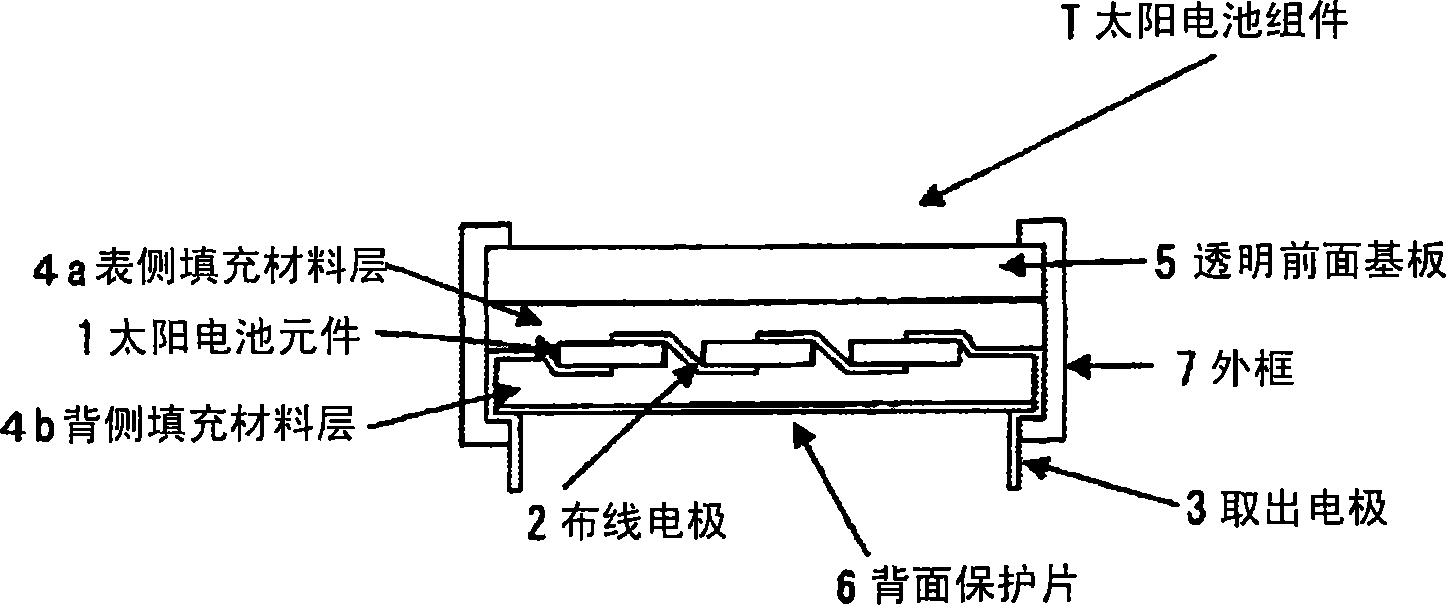Filler for solar cell module, solar cell module using same
A technology for solar cell components and filling materials, which is applied to electrical components, circuits, photovoltaic power generation, etc., can solve the problems of preventing white turbidity of filling materials that have not been proposed, and achieve the effect of suppressing white turbidity
- Summary
- Abstract
- Description
- Claims
- Application Information
AI Technical Summary
Problems solved by technology
Method used
Image
Examples
Embodiment 1
[0130] (Preparation of Silane Modified Resin)
[0131] For a density of 0.898g / cm 3 In 100 parts by weight of metallocene linear low-density polyethylene, 2.5 parts by weight of vinyltrimethoxysilane, 0.1 part by weight of dicumyl peroxide as a radical generator (reaction catalyst) were mixed, and the temperature was 200 ° C. Melt and knead to obtain a silane-modified resin.
[0132] (Preparation of master compound)
[0133] For crushing density 0.900g / cm 3 In 100 parts by weight of powder made of metallocene linear low-density polyethylene, 3.75 parts by weight of benzotriazole-based ultraviolet absorber, 5 parts by weight of hindered amine-based light stabilizer, and 0.5 parts by weight of phosphorus-based thermal stabilizer are mixed parts by weight, and then melted and processed to obtain a pelletized master compound.
[0134] (Production of filler material for solar cell module)
[0135] To 20 parts by weight of the silane-modified resin, 5 parts by weight of the mas...
Embodiment 2
[0139] (Preparation of master compound)
[0140] For a density of 0.898g / cm 3 In 30 parts by weight of the powdered metallocene linear low-density polyethylene, the mixing density is 0.900g / cm 3 70 parts by weight of metallocene linear low-density polyethylene, 7 parts by weight of benzotriazole-based ultraviolet absorber, 10 parts by weight of hindered amine-based light stabilizer, and 1 part by weight of phosphorus-based thermal stabilizer, and melted , processing to obtain a pelletized master compound.
[0141] (Production of filler material for solar cell module)
[0142] To 40 parts by weight of the silane-modified resin used in Example 1, 5 parts by weight of the master batch was mixed, and the density of polyethylene for addition was 0.900 g / cm 3 60 parts by weight of metallocene straight-chain low-density polyethylene, using the same method as Example 1, to prepare a filler material for solar cell modules.
[0143] Furthermore, the solar cell module was produced by...
Embodiment 3
[0145](Preparation of master compound)
[0146] For a density of 0.896g / cm 3 3.75 parts by weight of benzotriazole-based ultraviolet absorber, 2.5 parts by weight of hindered amine-based light stabilizer, and phosphorus-based thermal stabilizer 0.25 parts by weight of the agent was melted and processed to obtain a pelletized master compound.
[0147] (Production of filler material for solar cell module)
[0148] To 10 parts by weight of the silane-modified resin used in Example 1, 5 parts by weight of the master compound was mixed, and the density of polyethylene for addition was 0.900 g / cm 3 90 parts by weight of metallocene linear low-density polyethylene, using the same method as in Example 1, to prepare a filler material for solar cell modules.
[0149] Furthermore, the solar cell module was produced by the same method as Example 1.
PUM
| Property | Measurement | Unit |
|---|---|---|
| density | aaaaa | aaaaa |
| density | aaaaa | aaaaa |
| melting point | aaaaa | aaaaa |
Abstract
Description
Claims
Application Information
 Login to View More
Login to View More - R&D
- Intellectual Property
- Life Sciences
- Materials
- Tech Scout
- Unparalleled Data Quality
- Higher Quality Content
- 60% Fewer Hallucinations
Browse by: Latest US Patents, China's latest patents, Technical Efficacy Thesaurus, Application Domain, Technology Topic, Popular Technical Reports.
© 2025 PatSnap. All rights reserved.Legal|Privacy policy|Modern Slavery Act Transparency Statement|Sitemap|About US| Contact US: help@patsnap.com



